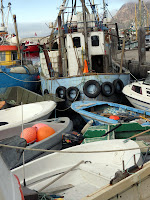GREENLAND throws up some
tongue-twisting names.
Looking at our destinations on
the itinerary the words appear to be a jumble of vowels and consonants so
complicated I don’t know where to start in saying them, but once I hear someone
announce these places I realise they are not only easy but often very poetic.
Yesterday it was Kangerlussauq
(kanger-loo-sack) and today it’s Sisimuit (si-si-moot) which, boasting around 6000
residents, is one of Greenland’s larger settlements with locals living in the
streets stretching back from the busy port.
People have been living in
Sisimuit for centuries – it’s long been home to a thriving fishing fleet and
there was even a cannery here for a few years – but it blossomed when the
Danish government decided it was time to bring the residents of the smaller
settlements that once dotted the coast into town.
The area was subdivided during the 1970s, with the first simple cabins built to accommodate the newest residents, and now the traditional ways are taking a backseat as the Inuit adapt to living in large communities that are regularly resupplied with everything the people need to survive.
The area was subdivided during the 1970s, with the first simple cabins built to accommodate the newest residents, and now the traditional ways are taking a backseat as the Inuit adapt to living in large communities that are regularly resupplied with everything the people need to survive.
After riding the zodiacs to shore
we toured the town with a local guide who told us there was still a bit of
unhappiness in the hamlet about the forced resettlement, with some of the older folks yearning for the days when they lived off the land, but the young people had
embraced the new life and were moving away from traditional professions to more
lucrative occupations.
"Skills like fishing were handed
from father to son," our guide Anita explained.
"But the sons have discovered
fishing is very hard work, and that there are now easier ways to make money, so
they aren’t doing that anymore and they aren’t teaching their sons how to do
something that was once so important."
The young local also shared the story behind the colours of the Sisimuit houses.
The young local also shared the story behind the colours of the Sisimuit houses.
When the Danish government moved
in it colour coded the public structures so locals who couldn’t read would be
able to find the buildings they needed when it came to apply for hunting
licences, enrol their children in school, and have a tooth pulled.
Next it was time to paint the houses and instead of importing new shades from Denmark, which was an expensive endeavour, the locals got their hands on the government surplus and covered their dwellings in the same vibrant tones.
After the excursion I received a
lesson in the complicated place names from cruise culturalist John Houston who explained
that most destinations were named after a feature that would help those
travelling through the region.
Next it was time to paint the houses and instead of importing new shades from Denmark, which was an expensive endeavour, the locals got their hands on the government surplus and covered their dwellings in the same vibrant tones.
I can only imagine how bright the
settlement looks when the neighbourhoods are covered in a thick layer of snow
and ice during the long and months of winter.
"Europeans name places as a
tribute to a sponsor – Prince of Wales Island, Victoria Island, King William
Island – so it’s a political thing or a token of possession," he explained.
"The Inuit organise space differently
by making a road map that would help future generations survive, so there are
places like 'bears live here island' and 'birds live here beach'."




















